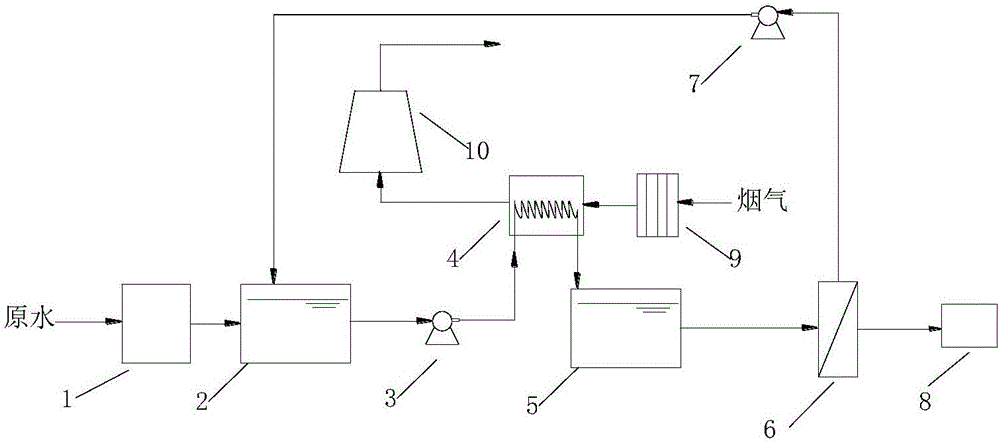Water treatment device and water treatment method utilizing flue gas waste heat
A water treatment device and flue gas waste heat technology, which is applied in seawater treatment, water/sewage treatment, biological water/sewage treatment, etc., can solve the problems of affecting desulfurization reaction and increasing water consumption of desulfurization process, so as to improve desulfurization efficiency and promote The effect of improving dust removal efficiency and saving water for desulfurization
- Summary
- Abstract
- Description
- Claims
- Application Information
AI Technical Summary
Problems solved by technology
Method used
Image
Examples
Embodiment 1
[0032] Example 1, such as figure 1 As shown, a water treatment device using flue gas waste heat in an embodiment of the present invention includes a pretreatment device 1, a regulating tank 2, a first water pump 3, a heat exchanger 4, an intermediate pool 5, a membrane distillation device 6, a second Water pump 7, water production tank 8, dust collector 9 and desulfurization tower 10.
[0033] The raw water to be treated enters the water inlet of the pretreatment device 1, the water outlet of the pretreatment device 1 is connected to the water inlet of the regulating tank 2, and the water outlet of the regulating tank 2 passes the water inlet of the first water pump 3 and the heat exchanger 4 The water outlet end of the heat exchanger 4 is connected with the water inlet end of the intermediate pool 5 .
[0034] The heat exchanger 4 is a single-stage heat exchanger, which is arranged before the flue gas inlet of the desulfurization tower 10, and the flue gas enters the flue ga...
Embodiment 2
[0047] Embodiment 2 is different from Embodiment 1 in that the heat exchanger 4 is a two-stage heat exchanger, including a high-temperature heat exchanger and a low-temperature heat exchanger, wherein the high-temperature heat exchanger is arranged at the flue gas inlet of the dust collector 9 Previously, the low-temperature heat exchanger was set before the flue gas inlet of the desulfurization tower 10, and the flue gas entered the flue gas inlet of the high-temperature heat exchanger, and the flue gas outlet of the high-temperature heat exchanger was connected to the flue gas inlet of the dust collector 9, and the dust collector 9 The flue gas outlet of the low temperature heat exchanger is connected to the flue gas inlet of the low temperature heat exchanger, and the flue gas outlet of the low temperature heat exchanger is connected to the flue gas inlet of the desulfurization tower 10.
[0048] Taking a coal-fired power plant in Northwest China (1 600MW) as an example, the...
PUM
 Login to View More
Login to View More Abstract
Description
Claims
Application Information
 Login to View More
Login to View More - R&D
- Intellectual Property
- Life Sciences
- Materials
- Tech Scout
- Unparalleled Data Quality
- Higher Quality Content
- 60% Fewer Hallucinations
Browse by: Latest US Patents, China's latest patents, Technical Efficacy Thesaurus, Application Domain, Technology Topic, Popular Technical Reports.
© 2025 PatSnap. All rights reserved.Legal|Privacy policy|Modern Slavery Act Transparency Statement|Sitemap|About US| Contact US: help@patsnap.com

